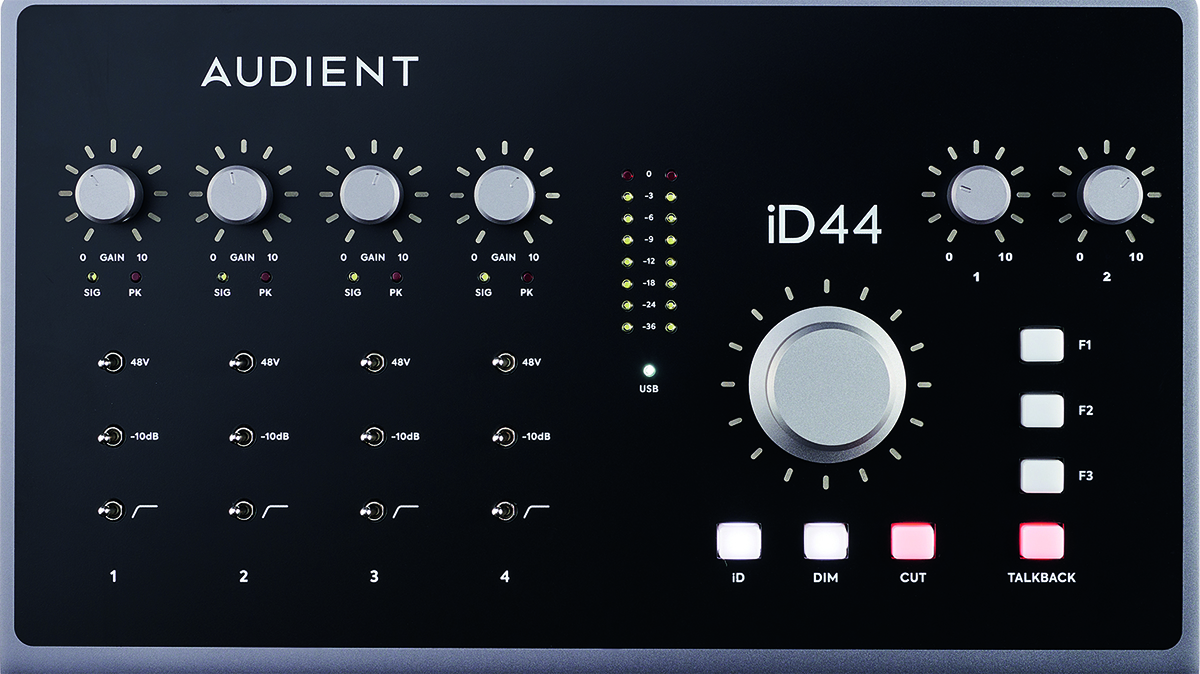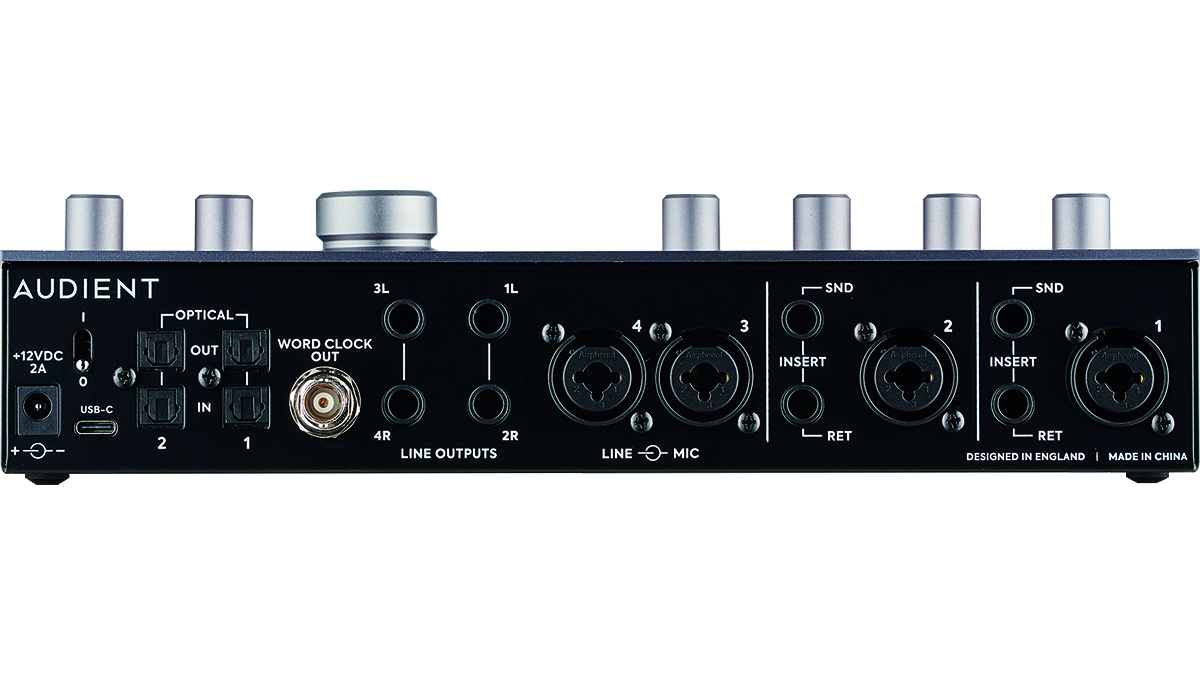MusicRadar Verdict
Audio quality is where this really shines; everything else is icing on the cake, but that icing is layered deep and tastes exceptionally sweet.
Pros
- +
Superb sound quality at this price level and above.
- +
Insert send/returns and Audio Loopback are very useful, usable features.
- +
Tough all-metal build.
Cons
- -
More analogue I/O would be nice but it’s not really a dealbreaker.
MusicRadar's got your back
Audient iD44 MkII: What is it?
The original iD44 audio interface is long in the tooth but this impressive refresh brings some welcome upgrades and a handful of nifty new features.
It was always an impressive bit of kit, yet the MkI always looked a bit ‘meh’ in its uninspired silver and black livery. What a splash of paint can do.
Less trivially, the iD44’s primary strength was always the superb quality of its mic pres and converters. This version ramps up the performance even further. Somehow, Audient has managed to improve the iD44’s Analogue to Digital Converter (ADC) THD+N figure by an impressive 9dB to a class-leading 112dB.
The Digital to Analogue Converters (DAC) are similarly pristine, with imperceptible noise and 126dB of dynamic range.
It may only boast four mic pres but they’re exactly the same model you’ll find in Audient’s pro-level consoles. Designed by engineering legend David Dearden back in the 1990s, this mic pre is revered for its high gain, low noise, low distortion and faithful character.
If you use dynamic mics you’ll be pleased to learn that there’s 60dB of clean gain on tap, so you can stick your Cloudlifter or FetHead on eBay.
The instrument ins are modelled to replicate the input stage of a classic valve amplifier, but the effect is suitably subtle.
Want all the hottest music and gear news, reviews, deals, features and more, direct to your inbox? Sign up here.
The independent headphone outs are interesting too in that channel one has both ¼” and mini-jack sockets, which is useful if you’ve misplaced your jack adapter or need to run audio to a third person (though they will hear exactly the same output). Output impedance is <50 Ω, so they’ll work with all grades of headphones.

Audient iD44 MkII: Performance and verdict
The simple yet comprehensive controls on the top panel are generously spaced and there’s no call for menu diving. Working from the left, there’s a gain dial for each of the four mic pres, below which there are signal and clipping LEDs plus phantom power, -10dB pad and high-pass filter toggle switches.
One of our few criticisms of the iD44 is that the level meter only shows the output level and not the input level, which is a real shame.
The large output volume knob doubles as a mouse scroll wheel that proves dead useful for adjusting parameters in your DAW. Below this, there’s an iD button that toggles the output/scroll wheel function, a DIM button that instantly reduces output to a pre-defined level and a CUT (mute) button. To the right are three user-configurable shortcut buttons plus a talkback button. Usefully, the iD44 can use a USB mic or your PC for talkback, freeing up the mic pres.
Channels 1 and 2 boast balanced send and return inserts, nifty for hooking up external hardware such as compressors and EQ. You can also reach the converters directly by solely plugging into the return, which will bypass the mic pres in the signal chain. These are rarely found on interfaces at this price point.

If you have the gear, the ADAT ports let you expand the total number of inputs and outputs by 16 (20-in, 24-out, hence 44) but part of us really wishes there was more onboard analogue I/O. Still, at least there’s the provision for sizeable expansion.
The iD44 ships with Audient’s low-latency drivers and its comprehensive Software Mixer application, which does what it says on the tin but also enables you to alter defaults such as the DIM level.
The application also reveals the new Audio Loop-back feature, useful for podcasters and the like. In essence, Loopback lets you record audio from computer on separate channels to your mics, providing a lot of versatility when mixing. This, plus the ability to work seamlessly with low-sensitivity condenser mics, makes it attractive for content creators and musos alike.
MusicRadar verdict: Audio quality is where this really shines; everything else is icing on the cake, but that icing is layered deep and tastes exceptionally sweet.
Audient iD44 MkII: The web says
"The combination of console-grade preamps, insert points, and well-executed converters gives results that would challenge hardware that sits a lot further up the price scale, and is sure to impress even the most discerning of users."
MusicTech
Audient iD44 MkII: Hands-on demos
Audient
Julian Krause
BenoniStudio
Produce Like A Pro
Audient iD44 MkII: Specifications
- KEY FEATURES: 20-in, 24-out USB audio interface. 4 x Class-A Audient Console Mic Preamps, Class Leading AD/DA Converters, 2 x Discrete JFET Instrument Inputs, Main and Alt Speaker Outputs, 1 x Independent Headphone Output, 1 x Independent Dual Headphone Output, 2 x ADAT Inputs & Outputs for Digital Expansion, 2 x Fully Balanced Inserts, Audio Loop-back, ScrollControl, +48V phantom power.
- CONTACT: Audient
When Simon's childhood classical guitar teacher boasted he 'enjoyed a challenge', the poor man had no idea how much he'd underestimated the scale of the task ahead. Despite Simon's lack of talent, the experience did spark a lifelong passion for music. His classical guitar was discarded for an electric, then a room full of electrics before Simon discovered the joys of keys. Against all odds, Simon somehow managed to blag a career as a fashion journalist, but he's now more suitably employed writing for MusicRadar and Guitar World. When not writing or playing, he can be found terrifying himself on his mountain bike.

